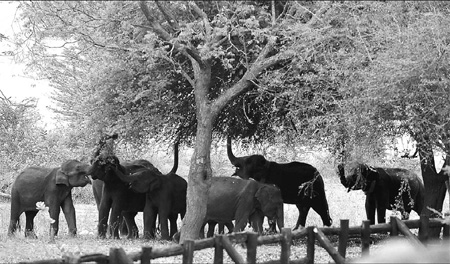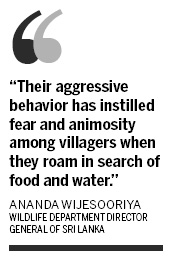Asia-Pacific
Living with really big babies
(China Daily)
Updated: 2010-05-18 08:08
 |
Large Medium Small |
LUNUGAMWEHERA, Sri Lanka - In the early hours of a hot dry day, four orphaned elephants begin a bumpy truck ride back to the jungles of southern Sri Lanka where they had been rescued from near certain death.
 Orphaned baby elephants graze at the state-run Elephant Transit Home in Udawalawe. Home to some 10 percent of the Asian elephant population, Sri Lanka is erecting electrical fences around villages, so people can live in harmony with wild elephants that are fast dwindling due to human-elephant conflicts. ISHARA S.KODIKARA / Agence France-Presse |
The four baby jumbos - now aged 5 and 6 - are ready to leave the Elephant Transit Home where they have been treated and cared for since they were less than a year old.
The state-run home is refuge for dozens of baby elephants who are separated from their herds, fall into wells or ditches or are shot at by angry farmers as they raid banana, rice and sugarcane farms for food.

A one-hour drive takes Ollie, Toledo, Zicasso and Rani to the release site deep inside the Lunugamwehera national park. To rid them of human odor, they are hosed with elephant dung mixed in water.
The wildlife department staff clasps their hands in prayer while a saffron-robed Buddhist monk chants blessings for the elephants' future.
At first they seem surprised by the lack of fences, but soon lumber off into the undergrowth.
The release is a special day for the caregivers and conservationists, who hail the program as a successful method of re-integrating animals into the wild and saving Sri Lanka's dwindling elephant population.
"They look cute and cuddly, but their survival is under threat," Wildlife Department director general Ananda Wijesooriya said as he watched his former patients disappear.
Over the next few months, satellite radio collars will hopefully show female Rani integrating into a herd and the three males establishing their individual roaming areas, said project veterinary surgeon Neshma Kumudhini.
The number of elephants in the country is estimated to have dropped from 12,000 in 1900 to just 4,000 now. Two-thirds live outside protected parks in shrinking habitats, and constantly come into conflict with humans.
Hundreds of elephants are killed annually by villagers, while marauding herds also trample locals to death.
In 2009, the conflict claimed the lives of 50 people and 228 elephants, the highest toll in recent times, said Wijesooriya.
"Their aggressive behavior has instilled fear and animosity among villagers when they roam in search of food and water," he explained.
Elephants have long been an integral part of Sri Lankan culture, and are a religious symbol for both the majority Buddhist and minority Hindu communities.
But they also clash with humans, said specialist elephant biologist Manori Gunawardena. "It's like having a really bad next-door neighbor," said Gunawardena, who knew a farmer killed last year by a lone elephant.
Finding solutions to the problem in Sri Lanka, which finally ended a decades-long ethnic conflict with Tamil Tiger rebels a year ago, has been virtually impossible for conservationists.
For decades, efforts to move the elephants away from villages using loudspeakers and firecrackers have failed. Most relocated elephants try to return to their original territory.
Between 2005 and 2006, the government spent $1.5 million to drive elephants from the island's far south towards a park in the southwest.
Officials moved some 250 elephants - mostly herds of females, babies and juveniles - but more than 300, including the adult males, escaped the operation.
"Elephants are very intelligent, they are very attached to their original home ranges and most often always try to come back," said Prithiviraj Fernando, who heads the Sri Lankan Center for Conservation and Research.
The government increasingly works with private conservationists to protect villages with electric fences.
Under a proposed $20 million World Bank loan, the new model will be tested in the island's south, where a slew of infrastructure projects including a new international airport, port and a cricket stadium are being built.
"We must accept that the human-elephant conflict will never be solved. For that to happen, either the humans or the elephants must be eliminated," said World Bank lead environmental specialist Sumith Pilapitiya.
Agence France-Presse






